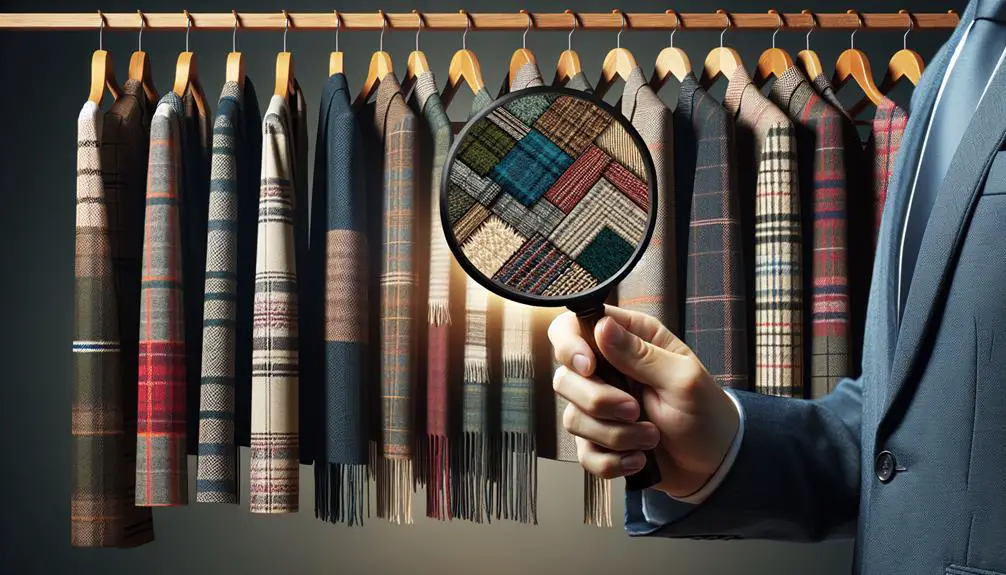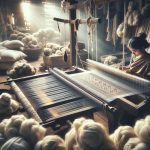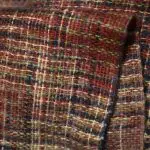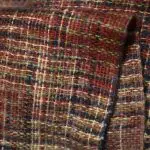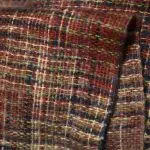So, I've been thinking a lot about tweed lately. It's this really interesting fabric that's made mostly from wool. What's cool about it is how it's woven—there are all these different patterns and styles, depending on where it's made. You've probably seen it in those classic British hunting jackets, right? But there's more to tweed than meets the eye. For instance, have you ever wondered how tweed holds up against other materials regarding durability and comfort? And what about its environmental impact? There's a lot to unpack here, so let's get into it.
Table of Contents
Key Takeaways
- Tweed is a durable fabric primarily woven from wool.
- It originated in Scotland, designed for resilience in harsh weather conditions.
- Tweed features distinctive patterns such as herringbone, check, and plaid.
- The fabric is known for its texture and depth, achieved through various weaving techniques.
- Regional variations like Harris Tweed and Donegal tweed highlight unique styles and craftsmanship.
Origins of Tweed
Tweed's journey began on the windy, rugged islands of Scotland, where local weavers crafted the durable fabric to withstand harsh weather. I've always been fascinated by how this practical need gave rise to a material that's now globally recognized and steeped in cultural significance. Historically, tweed was integral to the Scottish rural economy, evolving from a local craft to a significant trade item.
The name 'tweed' itself is a twist of fate. It's said to have originated from a London merchant's misreading of 'tweel,' the Scots' word for twill, as 'tweed'—a major river in Scotland. This serendipitous error marked the fabric's shift from a local staple to an internationally known product. Tweed's cultural significance is deeply tied to its Scottish roots, embodying a blend of necessity and craftsmanship that reflects the ethos of the communities that created it. The fabric's robust, earthy quality echoes the landscapes of its origin, making it a symbol of Scottish resilience and ingenuity.
As I explore further into tweed's origins, I'm struck by how these historical anecdotes not only tell the tale of a fabric but also paint a picture of a people and a place.
Basic Composition
Let's start by looking at where tweed fibers come from and what makes them unique.
Next, I'll explain the common weaving techniques used to create different tweed patterns.
Understanding these basics will help us appreciate why tweed has such a distinctive look and feel.
Tweed Fiber Origins
Tweed is primarily made from wool, sourced directly from sheep. The process of converting raw wool into the durable tweed fabric we all admire involves several steps that enhance its natural properties. Tweed's durability, for instance, comes from both the type of wool used and the specific methods employed during tweed processing. These steps guarantee the fabric can withstand wear and tear while maintaining its aesthetic appeal.
To give you a clearer picture, here's a quick rundown of essential aspects:
| Aspect | Description | Importance |
|---|---|---|
| Fiber Source | Wool from sheep | Base material |
| Durability | Enhanced by processing | Longevity of tweed |
| Processing | Cleaning, carding, spinning | Quality of fabric |
This foundation sets tweed apart in the world of textiles.
Common Weaving Techniques
Exploring common weaving techniques reveals how their intricate patterns contribute to tweed's unique texture and strength. When I investigate the craft of making tweed, I'm particularly intrigued by how different loom types and thread tension play vital roles. Understanding these elements helps in mastering the fabric's production.
Here's what stands out:
- Plain Weave: The simplest yet strong, interlacing at right angles.
- Twill Weave: Creates diagonal lines, offering more drape and resilience.
- Herringbone: A variation of twill, known for its distinctive V-shaped weaving pattern.
- Barleycorn: Rich, textured, and typically heavier, showing pronounced, bumpy patterns.
Each technique impacts the feel and durability of tweed, making it essential to choose the right method for the desired end use.
Weaving Techniques
I'll explore how tweed is woven, zeroing in on the specific techniques that give it its unique texture. The crafting of tweed involves important loom settings and thread tension, which are vital for achieving the fabric's distinctive, rugged feel. Adjusting the loom settings allows weavers to control the density and weight of the tweed. Thread tension, on the other hand, must be carefully managed to avoid any unwanted puckering or irregularity, ensuring the fabric remains smooth yet textured.
Tweed's weaving process often utilizes a twill pattern, where the weft thread crosses over one or more warp threads then under two or more, creating a diagonal ribbing. This not only enhances the fabric's durability but also contributes to its characteristic look. Additionally, the use of multiple colored threads can create subtle patterns and depth in the coloration, making each tweed piece unique.
To master tweed weaving, understanding the interplay between thread tension and loom settings is essential. Each adjustment can change the drape and feel of the final product. By manipulating these elements, weavers express their artistic vision and craft a material that's as functional as it's beautiful.
Regional Variations
As we explore regional variations of tweed, it's fascinating to see how each area stamps its unique mark on this classic fabric.
Scottish Harris Tweed is renowned for its rugged durability, while Irish Donegal patterns are celebrated for their colorful speckles.
Over in England, tweed styles often showcase more subtle, refined patterns that suit a variety of formal and casual occasions.
Scottish Harris Tweed
While Scottish Harris Tweed shares similarities with other tweeds, its distinct regional variations set it apart. Known for its exceptional Harris durability, this fabric exemplifies the craft of Island production. Originating from the Outer Hebrides, the material isn't just about warmth and aesthetics; it's a reflection of a unique geographical identity.
Here's why Harris Tweed is special:
- Protected Status: Only tweed made in the Outer Hebrides can be legally called Harris Tweed.
- Handwoven Tradition: Artisans weave it on treadle looms at their homes.
- Local Wool: The wool is sourced exclusively from local sheep.
- Dyeing Process: Natural dyes from the island contribute to its unique color palette.
This tweed isn't just fabric; it's a piece of Scottish heritage.
Irish Donegal Patterns
Now let's explore Irish Donegal patterns, known for their unique speckles and vibrant color blends. This style of tweed is rooted deeply in the tradition and landscape of County Donegal. The speckled patterns aren't just for show; they carry rich symbolism and history. Each color and pattern reflects elements of the natural surroundings, like the greens of the lush fields or the grays of the rocky cliffs. This isn't just fabric; it's a narrative woven from the land itself.
The color significance in Donegal tweed is particularly profound. Colors are chosen based on their connection to Irish heritage and the natural beauty of the region. Wearing Donegal tweed is more than a fashion choice; it's an homage to Irish culture and history.
English Tweed Styles
Let's shift our focus to the diverse styles of English tweed, each with its own regional twist. Rooted in tradition, the fabric durability and style evolution of English tweed are well-celebrated. From the rugged moors to bustling city streets, each style reflects its environment.
Here's a quick rundown of key variations:
- Harris Tweed: Known for its exceptional durability and rich, intricate patterns.
- Herringbone: Iconic V-shaped weaving pattern, often found in Yorkshire.
- Check Tweed: Features a grid-like pattern, popular in regions like Suffolk.
- Barleycorn: Distinctive, pebbled texture that mimics the barley seed, commonly seen in the Cotswolds.
Each style not only protects against the elements but also tells a story of regional craftsmanship.
Color and Pattern Styles
How do the colors and patterns of tweed define its character and appeal?
Well, it's all about the interplay of dyeing methods and texture effects. Tweed's unique aesthetic starts with how the wool is dyed. Traditional techniques involve blending various colored fibers before they're spun into yarn. This process creates those deep, mixed hues that are so characteristic of tweed.
The patterns, too, aren't just about looks; they're about craftsmanship. Classic patterns like herringbone, check, and plaid are achieved through specific weaving techniques that not only add visual depth but also enhance the fabric's texture. Each pattern has a way of catching the light differently, which showcases the rich color variations created by the earlier dyeing process.
What's fascinating is how these elements combine to give tweed its distinctive feel and appearance. For instance, the way a dark brown weave contrasts with subtle flecks of gold or how a soft gray forms a muted background for brighter threads. It's this complexity in color and pattern that makes tweed so versatile and enduringly popular, appealing to both traditional and contemporary tastes.
Iconic Tweed Items
Throughout the years, tweed has been crafted into several iconic items that stand out in both fashion and functionality. Its enduring appeal is often bolstered by celebrity endorsements, which have helped to maintain its status as a stylish and sophisticated material. Let's explore some of the most renowned tweed items that have captured the imagination of fashion enthusiasts worldwide.
Firstly, the tweed jacket is perhaps the quintessential tweed item. It's been a staple in wardrobes from the Scottish Highlands to the chic streets of Paris. Its versatility is unmatched, easily dressing up a casual outfit or adding a touch of class to formal wear.
Furthermore, tweed accessories have gained substantial traction in fashion circles. Items like:
- Tweed caps
- Tweed scarves
- Tweed handbags
- Tweed shoes
These accessories complement any outfit, providing that extra layer of texture and depth that only tweed can offer. Importantly, celebrities often flaunt tweed accessories, enhancing their appeal and driving trends within the fashion industry.
Care and Maintenance
Now that we've explored some popular tweed items, I'll show you how to keep them looking their best. Tweed's durability is one of its hallmarks, but proper care and maintenance are key to ensuring it lasts. Let's delve into some essential tips, focusing particularly on stain removal and storage solutions.
When it comes to stain removal, acting promptly is essential. Avoid rubbing the fabric harshly, as this can work the stain deeper into the fibers. Instead, blot gently and use a mild soap solution if necessary. For tougher stains, consider a professional cleaner who specializes in tweed.
Proper storage is equally important. Tweed should be stored in a cool, dry place to avoid mildew and moth damage. Using breathable garment bags and padded hangers can help maintain the shape and integrity of the fabric. Here's a quick reference table for you:
| Maintenance Action | Tool/Supply Needed | Tips |
|---|---|---|
| Stain Blotting | Clean Cloth | Blot, don't rub |
| Mild Washing | Mild Soap | Gentle hand wash |
| Dry Cleaning | Professional | For tough stains |
| Storage | Breathable Bag | Avoid plastic |
| Hanging | Padded Hanger | Keep shape intact |
Tweed in Fashion Today
As we look at tweed in today's fashion scene, it's clear that contemporary designers have embraced its rich texture and heritage.
They're innovating with tweed, proving its versatility beyond traditional jackets and coats.
It's exciting to see how tweed is being adapted for everything from casual wear to high fashion.
Contemporary Tweed Designers
Revamping traditional styles, contemporary tweed designers are weaving innovation into every thread. I've noticed a thrilling push towards blending classic tweed with modern aesthetics at various fashion shows. Designer collaborations have also become a key trend, where timeless materials meet cutting-edge design. This fusion isn't just invigorating—it's revolutionary.
Here's what makes today's tweed stand out:
- Innovative Weaving Techniques: Using advanced technology to create lighter, more versatile tweed.
- Bold Color Palettes: Moving beyond the classic earth tones to include vibrant, unexpected colors.
- Modern Silhouettes: Tweed incorporated into contemporary cuts that appeal to a younger audience.
- Eco-conscious Production: Emphasis on sustainable practices in the tweed production process.
These elements invigorate tweed, ensuring its relevance and continued popularity in modern fashion.
Tweed's Versatility in Apparel
Building on the innovation of contemporary designers, tweed's versatility shines through in today's fashion scene. As I've explored, this fabric isn't just for the countryside anymore. Tweed's insulation properties make it perfect for modern outerwear, keeping you warm without sacrificing style. You'll see it in everything from sleek bomber jackets to chic blazers.
Moreover, tweed's integration into formal wear is striking. It's being tailored into sharp, sophisticated suits that command respect in any boardroom. The texture adds a touch of heritage while keeping the look fresh and contemporary. I've noticed how designers are playing with colors and patterns to give tweed a more modern appeal, ensuring it remains a staple in both casual and formal fashion arsenals.
Environmental Impact
Tweed production's environmental impact is significant, primarily due to the extensive use of water and chemicals in processing wool. As I've explored further into the sustainability of textiles, I've discovered that while tweed is praised for its durability, the environmental cost can be quite steep. The conventional methods of producing tweed involve not only high water consumption but also the use of dyes and finishes that can contribute to pollution levels in water systems.
Particularly concerning is how these practices affect local ecosystems. However, advancements in recycling processes are beginning to pave the way for more sustainable tweed production:
- Water recycling systems: Reducing freshwater usage by recycling process water.
- Biodegradable chemicals: Shifting from synthetic to natural dyes and mordants.
- Local sourcing of materials: Minimizing transportation emissions.
- Energy-efficient manufacturing: Lowering the carbon footprint of production facilities.
These initiatives are instrumental in mitigating the negative impacts of tweed production. I'm optimistic about the industry's shift towards these methods, which not only preserve the environment but also guarantee the longevity and ethical production of the beloved tweed fabric. As consumers, understanding these factors helps us make more informed choices, aligning our fashion preferences with our environmental values.
Purchasing Tips
When shopping for tweed, it's important to take into account both quality and ethical production practices. I've learned that doing a bit of homework before making a purchase can save you not only money but also guarantee you're investing in a product that aligns with your values. Here's a quick guide I put together to help you navigate your next tweed purchase.
| Factor | What to Check | Why It Matters |
|---|---|---|
| Fabric Durability | Weave density and fiber | Ensures longevity and resistance to wear |
| Ethical Production | Certifications, company policies | Supports fair labor and sustainable practices |
| Price Comparison | Competitor pricing, seasonal discounts | Gets you the best deal for high quality tweed |
Always touch the fabric to gauge its thickness and texture. Durable tweed should feel sturdy yet comfortable. Don't shy away from asking retailers about the source of their tweed and the production methods used. It's your right to know.
Frequently Asked Questions
Can Tweed Be Dyed After It Has Been Woven?
Yes, I've found that tweed can be dyed after it's been woven, but it's vital to use the right dyeing techniques to guarantee color stability. Always test on a small piece first!
How Does Tweed React to Different Weather Conditions?
Tweed's insulation properties keep me warm, while its water resistance handles light rain well. However, in heavy weather, it's not completely waterproof, so I don't rely on it during downpours.
Are There Hypoallergenic Tweed Options Available?
I've discovered that some tweed options include hypoallergenic fabric blends, which are great for sensitive skin. Always check the labels and consider allergy testing to make sure you're picking the right fabric for you.
Can Tweed Be Used for Summer Clothing?
Yes, tweed can be used for summer clothing, especially if it's a lighter weave. Its breathability depends on the weave and weight, making it adaptable for summer styling when chosen carefully.
What Alternatives Exist for Those Allergic to Tweed?
For those allergic to tweed, fabric substitutes like cotton, linen, or synthetic blends can be great options. They're hypoallergenic and avoid typical allergy triggers found in heavier, rougher materials like tweed.
- What Kind of Material Is Tweed? - April 24, 2024
- Why Is Tweed so Expensive? - April 24, 2024
- Is Organza Stretchy? - April 24, 2024

